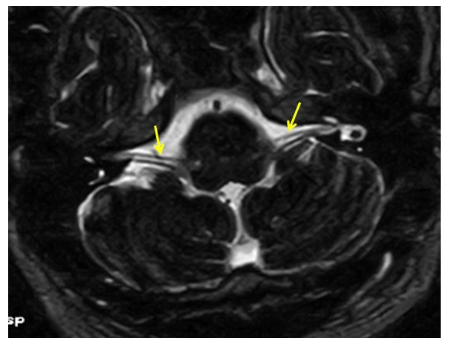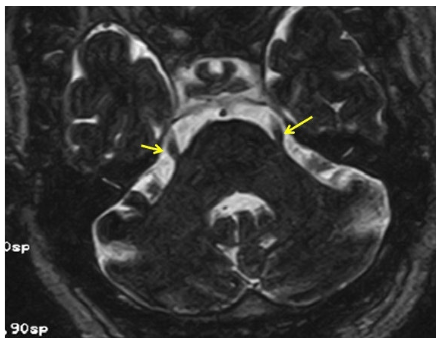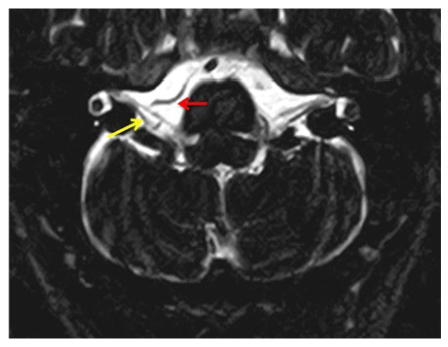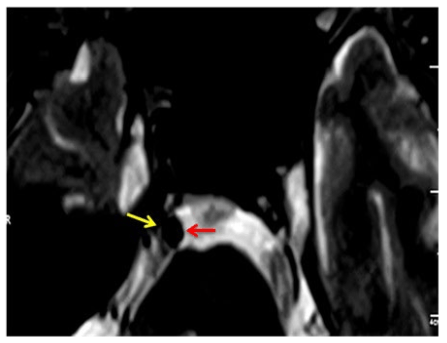1. Joffroy A, Levivier M, Massager N. Trigeminal neuralgia: pathophysiology and treatment. Acta Neurol Belg. 2001; 101: 20-25.
2. Kitt CA, Gruber K, Davis M, Woolf CJ, Levine JD. Trigeminal neuralgia: opportunities for research and treatment. Pain. 2000; 85: 3-7. doi: 10.1016/S0304-3959(99)00310-3
3. Ruiz DS, Yilmaz H, Gailloud P. Cerebral developmental venous anomalies: current concepts. Ann Neurol. 2009; 66: 271-283. doi: 10.1002/ana.21754
4. Rhoton AL Jr. Cerebellopontine angle and the retrosigmoid approach. Neurosurgery. 2007; 61(Suppl 4): 175-192. doi: 10.1227/01.NEU.0000296224.77942.80
5. Rhoton AL Jr. Cerebellum and fourth ventricle. Neurosurgery. 2000; 47(Suppl 3): S7-S27. doi: 10.1097/00006123-200009001-00007
6. Rhoton AL Jr. The cerebellopontine angle and posterior fossa cranial nerves by the retrosigmoid approach. Neurosurgery. 2000; 47(Suppl 3): S93-S129. doi: 10.1097/00006123-200009001-00013
7. Samii M, Gerganov V. Microsurgical anatomy of the cerebellopontine angle by the retrosigmoid approach. Surgery of cerebellopontine lesions. Springer Berlin Heidelberg. 2013; 9-72. doi: 10.1007/978-3-642-35422-9_2
8. Cross J, Coles A. The cerebellopontine angle. ACNR. 2002; 2(3): 16-17.
9. Sarrazin J-L, Marsot-Dupuch K, Chaÿas A. Angle ponto cerebellar pathology. (French) J Radiol. 2006; 87: 1765-1782.
10. Bonafé A. Neurovascular conflicts APC. (French) J Radiol. 2000; 81; 694-701.
11. Parise M, Acioly MA, Ribeiro CT, Vincent M, Gasparetto EL. The role of the cerebellopontine angle cistern area and trigeminal nerve length in the pathogenesis of trigeminal neuralgia: a prospective case-control study. Acta Neurochir (Wien). 2013; 155(5): 863-868. doi: 10.1007/s00701-012-1573-0
12. Campos-Benitez M, Kaufmann AM. Neurovascular compression findings in hemifacial spasm. J Neurosurg. 2008; 109: 416-420. doi: 10.3171/JNS/2008/109/9/0416
13. Baliazina EV. Topographic anatomical relationship between the trigeminal nerve trunk and superior cerebellar artery in patients with trigeminal neuralgia. Morfologiia. 2009;136(5): 27-31.
14. Samii M, Gunther T, Iaconetta G, Muehling M, Vorkapic P, Samii A. Microvascular decompression to treat hemifacial spasm: long-term results for a consecutive series of 143 patients. Neurosurgery. 2002; 50: 712-718. doi: 10.1097/00006123-200204000-00005
15. Amin-Hankani S. Venous Angiomas. Curr Treat Options Cardiovasc Med. 2011; 13(3): 240-246. doi: 10.1007/s11936-011-0118-9
16. Chiaramonte R, Bonfiglio M, D’Amore A, Chiaramonte I. Developmental venous anomaly responsible for hemifacial spasm. Neuroradiol J. 2013; 26(2): 201-207. doi: 10.1177/197140091302600210
17. Lagalla G, Logullo F, Di Bella P, Haghighipour R, Provinciali L. Familial hemifacial spasm and determinants of late onset. Neurol Sci. 2010; 31(1): 17-22. doi: 10.1007/s10072-009-0153-4
18. Yoshino N, Akimoto H, Yamada I, et al. Trigeminal neuralgia: evaluation of neuralgic manifestation and site of neurovascular compression with 3D CISS MR imaging and MR angiography. Radiology. 2003; 228(2): 539-545. doi: 10.1148/radiol.2282020439
19. Sindou M, Howeidy T, Acevedo G. Anatomical observations during microvascular decompression for idiopathic trigeminal neuralgia (with correlations between topography of pain and site of the neurovascular conflict): prospective study in a series of 579 patients. Acta Neurochir (Wien). 2002; 144(1): 1-12. doi: 10.1007/s007010200000
20. Yamakami I, Kobayashi E, Hirai S, Yamaura A. Preoperative assessment of trigeminal neuralgia and hemifacial spasm using constructive interference in steady state-three-dimensional Fourier transformation magnetic resonance imaging. Neurol Med Chir (Tokyo). 2000; 40(11): 545-555. doi: 10.2176/nmc.40.545
21. Borges A. Trigeminal neuralgia and facial nerve paralysis. Eur Radiol. 2005; 15: 511-533. doi: 10.1007/s00330-004-2613-9
22. van Kleef M, van Genderen WE, Narouze S, et al. Trigeminal neuralgia. Pain Practice. 2009; 9(4): 252-259. doi: 10.1002/9781119968375.ch1
23. Lee SH, Rhee BR, Choi SK. Cerebellopontine angle tumours causing hemifacial spasm: types, incidence, and mechanism in nine reported cases and literature review. Acta Neurochir. 2010; 152: 1901-1908. doi: 10.1007/s00701-010-0796-1
24. Esaki T, Osada H, Nakao Y, et al. Surgical management for glossopharyngeal neuralgia associated with cardiac syncope: two case reports. British Journal of Neurosurgery. 2007; 21(6): 599-602. doi: 10.1080/02688690701627138
25. Rushton JG, Stevens JC, Miller RH. Glossopharyngeal (vagoglossopharyngeal) neuralgia: a study of 217 cases. Arch Neurol. 1981; 38(4): 201-205. doi: 10.1001/archneur.1981.00510040027002
26. Anderson VC, Berryhill PC, Sandquist MA, Ciaverella DP, Nesbit GM, Burchiel KJ. High-resolution three-dimensional magnetic resonance angiography and three-dimensional spoiled gradient-recalled imaging in the evaluation of neurovascular compression in patients with trigeminal neuralgia: a double blind pilot study. Neurosurg. 2006; 58 (4): 666-673. doi: 10.1227/01.neu.0000197117.34888.de
27. Benes L, Shiratori K, Gurschi M, et al. Is preoperative high-resolution magnetic resonance imaging accurate in predicting neurovascular compression in patients with trigeminal neuralgia: a single-blind study. Neurosurg Rev. 2005; 28: 131-136. doi: 10.1007/s10143-004-0372-3
28. Leal PRL, Froment J-C, Sindou M. MRI sequences for the detection of neurovascular origin conflicts trigeminal neuralgia and predictive value for characterizing the conflict (in particular the degree of vascular compression). (French) Neurosurgery. 2010; 56(1): 43-49. doi: 10.1016/j.neuchi.2009.12.004
29. Elaini S, Miyazaki H, Rameh C, Deveze A, Magnan J. Correlation between magnetic resonance imaging and surgical findings in vasculo-neural compression syndrome. Int Adv Otol. 2009; 5(Suppl 3): 1-23.
30. Adigo AMY, Adjénou KV, Agoda-Koussema LK, et al. Neurovascular conflicts of cerebellar pontine angle: about three cases in Lome. (French) J Afr Imag Méd. 2015; 7(1): 79-85.
31. Chays A, Labrousse M, Bazin A, Pierot L, Rousseaux P. Neurovascular conflicts in cerebellopontine angle. Pathogenesis and surgical treatment. (French) e-memories of the National Academy of Surgery. 2010; 9(2): 95-99.
32. Sindou M, Leston J, Decullier E, Chapuis F. Microvascular decompression for trigeminal neuralgia: long-term effectiveness and prognostic factors in a series of 362 consecutive patients with clear-cut neurovascular conflicts who underwent pure decompression. J Neurosurg. 2007; 107 (6): 1144-1153. doi: 10.3171/JNS-07/12/1144
33. Adamczyk M, Bulski T, Sowińska J, Furmanek MI, Bekiesińska-Figatowska M. Trigeminal nerve-artery contact in people without trigeminal neuralgia: MR study. Med Sci Monit. 2007; 13(Suppl 1): 38-43.
34. Ruiz-Juretschke F, Vargas A, González-Rodrigalvarez R, Garcia-Leal R. Hemifacial spasm caused by a cerebellopontine angle arachnoid cyst: case report and literature review. Neurocirugia (Astur). 2015; 307-301. doi: 10.1016/j.neucir.2015.05.001
35. Misawa S, Kuwabara S, Ogawara K, et al. Abnormal muscle responses in hemifacial spasm: F waves or trigeminal reflexes? J Neurol Neurosurg Psychiatry. 2006; 77: 216-218. doi: 10.1136/jnnp.2005.073833
36. Prasanna K, Manoj B, Hajime Y, et al. Cerebellopontine angle endodermal cyst presenting with hemifacial spasm. Brain Tumor Pathol. 2011; 28: 371-374. doi: 10.1007/s10014-011-0042-4
37. Mastronardi L, Taniguchi R, Caroli M, Crispo F, Ferrante L, Fukushima T. Cerebellopontine angle arachnoid cyst: a case of hemifacial spasm caused by an organic lesion other than neurovascular compression: case report. Neurosurgery. 2009; 65: E1205. doi: 10.1227/01.NEU.0000360155.18123.D1
38. Alemdar M. Epidermoid cyst causing hemifacial spasm epidermoid cyst in cerebellopontine angle presenting with hemifacial spasm. J Neurosci Rural Pract. 2012; 3(3): 344-346. doi: 10.4103/0976-3147.102618
39. Khan Afridi EA, Khan SA, et al. Frequency of cerebellopontine angle tumours in patients with trigeminal neuralgia. J Ayub Med Coll Abbottabad. 2014; 26(3): 331-333.
40. Shenouda EF, Moss TH, Coakham HB. Cryptic cerebellopontine angle neuroglial cyst presenting with hemifacial spasm. Acta Neurochir (Wien). 2005; 147: 787-789. doi: 10.1007/s00701-005-0514-6
41. Cenzato M, Stefini R, Ambrosi C, Latronico N, Milani D. Surgical resolution of trigeminal neuralgia due to intra-axial compression by pontine cavernous angioma. World Neurosurg. 2010; 74(4-5): 544-546. doi: 10.1016/j.wneu.2010.03.035
42. Han IB, Chang JH, Chang JW, Huh R, Chung SS. Unusual causes and presentations of hemifacial spasm. Neurosurgery. 2009; 65(1): 130-137. doi: 10.1227/01.NEU.0000348548.62440.42
43. Duntze J, Litré CF, Eap C, et al. Endoscopy input for microvascular decompression in the cerebellopontine angle: about 27 cases. (French) Neurosurgery. 2011; 57(2): 68-72.
44. Zhu J, Li ST, Zhong J, et al. Microvascular decompression for hemifacial spasm. J Craniofac Surg. 2012; 23(5): 1385-1387. doi: 10.1097/scs.0b013e31825433d6
45. Li C, Li Y, Jiang C, Wu Z, Wang Y, Yang X. Remission of neurovascular conflicts in the cerebellopontine angle in interventional neuroradiology. J Neurointerv Surg. 2014. doi: 10.1136/neurintsurg-2014-011500
46. Dinichert A, Serrie A, Thurel C. Treatment of essential glossopharyngeal neuralgia by thermocoagulation or anesthetic blocking ganglion Andersch. (French) Pain: Evaluation-Diagnostic-Treatment. 2005; 6(1): 35-41.
47. Li P, Wang W, Liu Y, Zhong Q, Mao B. Clinical outcomes of 114 patients who underwent Gamma-knife radiosurgery for medically refractory idiopathic trigeminal neuralgia. Journal of Clinical Neuroscience. 2012; 19(1): 71-74. doi: 10.1016/j.jocn.2011.03.020
48. StanicS, FranklinSD, Pappas CT, Stern RL. Gamma knife radiosurgery for recurrent glossopharyngeal neuralgia after microvascular decompression. Stereotact Funct Neurosurg. 2012; 90: 188-191. doi: 10.1159/000338089
49. Harries AM, Dong CCJ, Honey CR. Use of endotracheal tube electrodes in treating glossopharyngeal neuralgia: technical note. Stereotact Funct Neurosurg. 2012; 90: 141-144. doi: 10.1159/000335714
50. Zhang W, Chen M, Zhang W, Chai Y. Use of electrophysiological monitoring in selective rhizotomy treating glossopharyngeal neuralgia. Journal of Cranio-Maxillofacial Surgery. 2014; 42(5): e182-e185. doi: 10.1016/j.jcms.2013.08.004
51. Duan Y, Sweet J, Munyon C, Miller J. Degree of distal trigeminal nerve atrophy predicts outcome after microvascular decompression for type 1a trigeminal neuralgia. J Neurosurg. 2015; 123(6): 1512-1518. doi: 10.3171/2014.12.JNS142086









